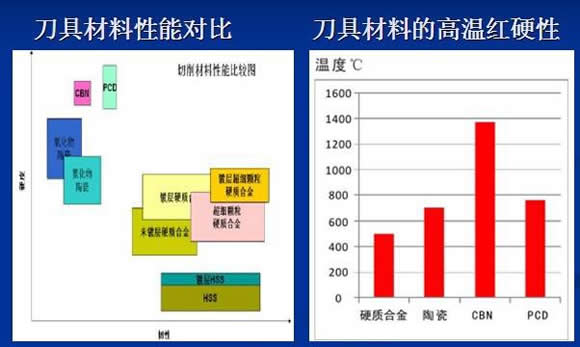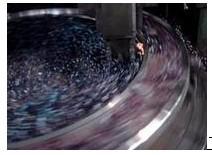Advantages of ceramic inserts in the field of metal cutting
Abstract The application of ceramic tools in machining is mainly in the form of indexable ceramic inserts such as CNC inserts, milling cutters and boring inserts for metal cutting. As an advanced tool material in the field of machining is becoming more and more widely used due to its high hardness and high speed cutting...
The application of ceramic tools in machining is mainly in the form of indexable ceramic inserts such as CNC cutter inserts, milling cutter discs and boring inserts for metal cutting. As an advanced tool material, it is more and more widely used in the field of machining. Due to its high hardness and high-speed cutting, wear-resistant and heat-resistant red hardness, it is a more advanced cutting tool than machining in carbide machining. material. In addition to the performance advantages of ceramic tools, its resource advantages are also increasingly replacing hard alloy CNC blades for more economical and environmentally friendly manufacturing. The tool materials have undergone several development stages such as carbon tool steel, high speed steel, hard alloy, ceramics and superhard materials. The hardness and red hardness performance of these tool materials are as follows:


Ceramic knives have changed the traditional machining process and solved many of the previously difficult machining problems in production. It is widely used in machinery, metallurgy, mining, high-speed trains, wind power, automobiles, tractors, bearings, pumps, transportation, energy, precision instruments, aerospace and other industries and has achieved significant economic benefits.
Traditional ceramic materials are generally taken from nature, such as the soil of Jingdezhen, and are processed into various daily necessities through mixing, forming and roasting. Modern high-tech ceramics, also known as special ceramics, are made of synthetic materials such as silicon nitride powder with high purity. Made by modern powder metallurgy process, the products have high hardness and high temperature resistance. Types and development of ceramic inserts: The most obvious development of ceramic inserts is the enhanced toughness of the inserts: alumina ceramic inserts - composite alumina ceramic inserts - silicon nitride ceramic inserts - cubic boron nitride inserts.
In the field of metal cutting, alumina ceramic blades and silicon nitride ceramic blades are collectively referred to as ceramic blades; in inorganic non-metal materials, cubic boron nitride materials belong to a large class of ceramic materials, and the introduction of cubic boron nitride material tools is The revolution of ceramic knives. China Hualing Superhard is one of the earliest research institutes in China to study polycrystalline cubic boron nitride materials. Recently, the pure boron nitride sintered ceramic insert has been introduced, and its toughness and wear resistance have increased significantly (for more information see: http:/ /?id=464)
Ceramic tool materials can be roughly classified into three types: alumina, silicon nitride and boron nitride. The excellent heat resistance, wear resistance and chemical stability of ceramic tools have the advantage that traditional tools can't match in high-speed cutting and cutting difficult materials. Ceramic tools have good cutting performance, but they can only be fully used if they are used correctly. With the development of ceramic technology and the expansion of the application of CNC machine tools and machining centers, the application of ceramic tools will become more and more extensive. The main raw material of ceramic knives is rich in the crust, which can be said to be inexhaustible, so the application prospect of new ceramic knives is very broad.
High purity ceramic
This is the earliest ceramic, and the improvement of inertness is focused on the atomization and high density of crystal grains. High-purity ceramics are cold pressed and hot pressed. The cold pressed ceramic is white, and the hot pressed ceramic is black.
Used in turning, planing, boring, milling, and manufacturing screws. Processing materials include soft cast iron, hot rolled and cold drawn carbon steel, brass, bronze, and aluminum. .
2. Composite ceramics
This is the current mainstream of ceramic tools for high-speed (cutting speed up to 800m / min) heavy cutting, milling and so on. Processing materials include hardened steel, chilled cast iron, superalloys, and other similar hard metals.
3. Silicon nitride ceramics
It is based on Si3N4 powder and adds an appropriate amount of Al2O3. It is made by atmospheric pressure sintering or hot pressing. For high speed (cutting speed up to 600m / min) heavy cutting, milling cast iron, cutting non-ferrous metals.
4. Boron nitride ceramics
It is a new high-tech product that is mainly used for turning, milling and boring superhard materials. The hardness of cubic boron nitride inserts is much higher than that of ceramic inserts. Due to its high hardness, it is also called superhard material with diamond. It is commonly used to process materials with hardness higher than RC48. It has excellent high temperature hardness - up to 2000 ° C, although It is more brittle than cemented carbide inserts, but its impact strength and crush resistance are significantly improved compared to ceramic inserts. In addition, some special cubic boron nitride inserts (Huacha Super Hard BN-S10 and BN-s20 grades) can withstand the chip load of rough machining and can withstand the impact of intermittent machining and wear during finishing. And cutting heat, these characteristics can meet the difficult processing of hard materials such as hardened steel with cubic boron nitride blades.
Hualing super-hard HLCBN series of sintered cubic boron nitride inserts can process large and difficult materials, especially in the strong interrupted cutting process, leading the whole superhard material cutting tool industry, HLCBN as a national superhard tool brand famous Overseas, it is unique in the world of superhard tooling.
Pure Boron Nitride Sintered Blade: The latest development of Hualing Superhard is a blade made of pure boron nitride material with a CBN content of 100%. The boron nitride ceramic insert formed by pure sintering has hardness and The thermal conductivity ratio is higher. When cutting high-hardness ferrous materials, the blade edge does not suffer from common thermal cracking and chipping; compared with CBN sintered bodies containing other bonding materials, the time of use of boron nitride ceramic blades can be Extend more than 6 times.
Tough HLCBN (non-metallic binder cubic boron nitride insert) cuts high hardness materials to reflect its impact toughness:
Compared with ceramic inserts, Hualing Super Hard's newly developed tough super-hard cubic boron nitride insert HLCBN tool is no longer so "squeezing", it is completely used in rough machining of high hardness material blank surface, such as milling high hardness quenching mold Steel, milled high-chromium cast iron and other wear-resistant alloys, bearing steel after grinding and quenching, carburizing steel.
1, Valin BN-S20 grade HLCBN blade milling high hardness high manganese steel tooth plate (intermittent processing hardness of HB500 high manganese steel castings):

2, Valin super hard BN-K1 grade toughness HLCBN blade rough processing high chromium alloy cast iron (processing hardness HRC60 or more Cr26 material industrial pump parts)

3, Valin super hard BN-S30 grade HLCBN blade high-speed milling gray cast iron (grey cast iron engine block high-speed fine milling line speed Vc = 1500m / min)

All of the above demonstrates the impact resistance of the tough HLCBN insert. The hardness and toughness of the tool are a contradiction. How to retain the hardness and wear resistance of the superhard material while making the tool and strengthen its impact toughness. The main research topic of Valin Superhard Tool since its establishment, and the introduction of non-metallic adhesive CBN tool (HLCBN tool) in 2007 broke the CBN tool can not be used in the field of strong intermittent processing and roughing, as super hard The leader in tool localization brands is a world leader in the field of hard material processing.
Led Emergency Inverter ,Rechargeable Inverter Led Bulb,Emergency Lighting Inverter,Smart Inverter Bulb
NINGBO JIMING ELECTRIC APPLIANCE CO., LTD. , https://www.feituosafety.com